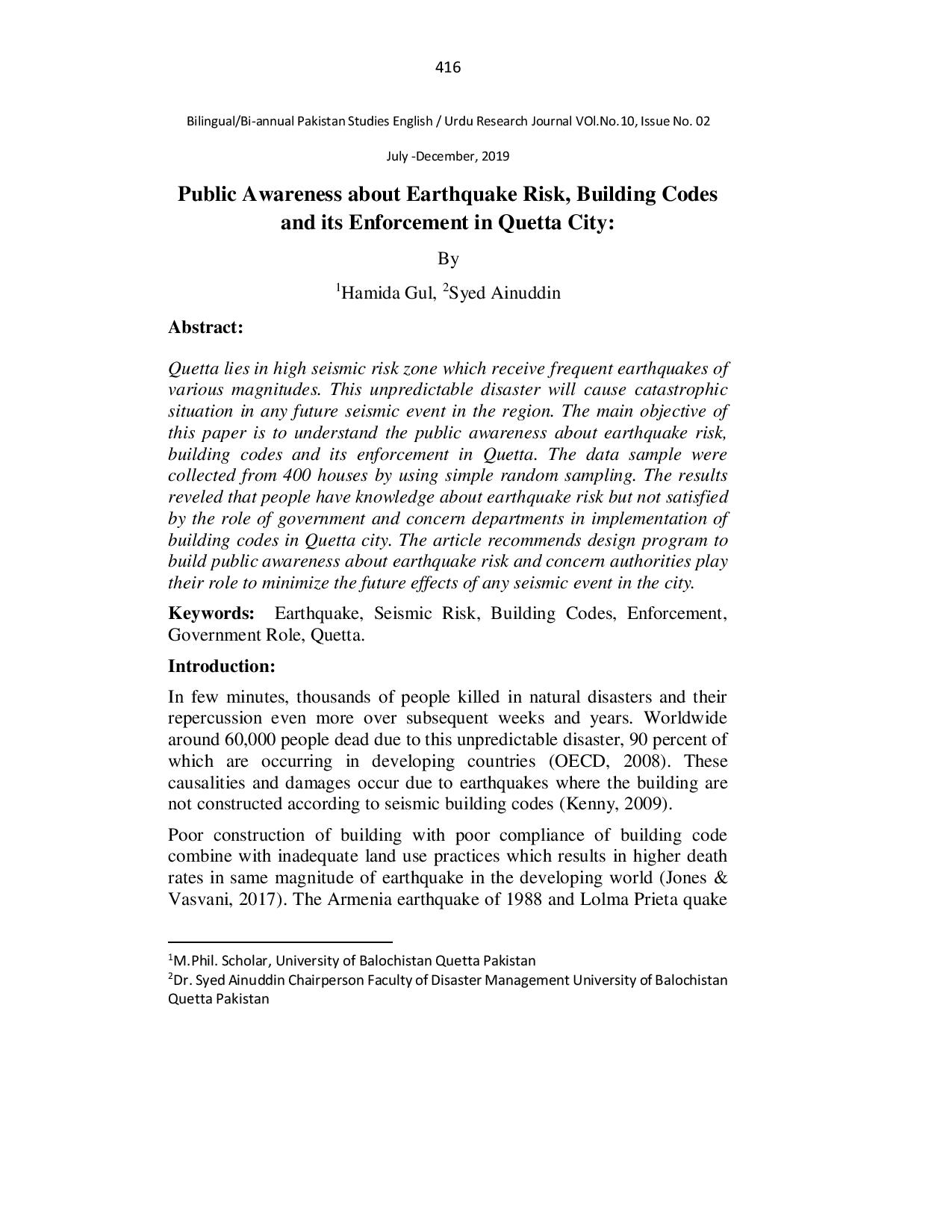Public Awareness about Earthquake Risk, Building Codes and its Enforcement in Quetta City
Keywords:
Earthquake, Seismic Risk, Building Codes, Enforcement, Government Role, Quetta.Abstract
Quetta lies in high seismic risk zone which receive frequent earthquakes of
various magnitudes. This unpredictable disaster will cause catastrophic
situation in any future seismic event in the region. The main objective of
this paper is to understand the public awareness about earthquake risk,
building codes and its enforcement in Quetta. The data sample were
collected from 400 houses by using simple random sampling. The results
reveled that people have knowledge about earthquake risk but not satisfied
by the role of government and concern departments in implementation of
building codes in Quetta city. The article recommends design program to
build public awareness about earthquake risk and concern authorities play
their role to minimize the future effects of any seismic event in the city.
References
Adikari, Y., & Yoshitani, J. (2009). Global Trends in Water-Related
Disasters : an insight for policymakers The United Nations World
Water Development Report 3 Water in a Changing World, 1–24.
Ainuddin, S., Kumar Routray, J., & Ainuddin, S. (2014). People’s risk
perception in earthquake prone Quetta city of Baluchistan.
International Journal of Disaster Risk Reduction, 7, 165–175.
https://doi.org/10.1016/j.ijdrr.2013.10.006
Ainuddin, S., Mukhtar, U., & Ainuddin, S. (2014). Public perception about
enforcement of building codes as risk reduction strategy for seismic
safety in Quetta, Baluchistan. International Journal of Disaster Risk
Reduction, 9, 99–106.
Bilham, R., Lodi, S., Hough, S., Bukhary, S., Khan, A. M., & Rafeeqi, S. F.
A. (2007). Uncertain Past , Uncertain Future. Seismological
Research Letters, 78(6), 601–613.
Jones, S., & Vasvani, V. (2017). Compliance with the building byelaws and
earthquake safety in urban areas of Bihar: progress, constraints and
challenges. Environmental Hazards, 16(4), 345–362.
Kenny, C. (2009). Why Do People Die in Earthquakes? The Costs , Benefits
and Institutions of Disaster Risk Reduction in Developing
Countries. Policy Research Working Paper, 4823(January 2009), 1–
Kumar, SL. (1933). Theory of earthquake resisting design with a note on
eartgquake resistingg construction in Balochistan. Engineering
Congress, Paper no. 165
Naseer, A., Naeem Khan, A., Hussain, Z., & Ali, Q. (2010). Observed
seismic behavior of buildings in Northern Pakistan during the 2005
Kashmir earthquake. Earthquake Spectra, 26(2), 425–449.
OECD. (2008). OECD Annual Report, 2008, 118.
PDMA. (2006). Provisional Disaster Management Plan for Balochistan,
Quetta, Pakistan.
Seismic Provisions. (2007). Building Code of Pakistan (Seismic Provisions
, 303.



